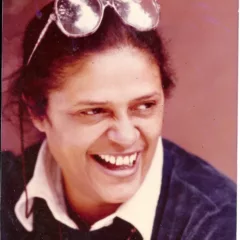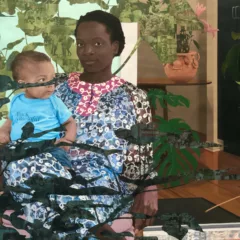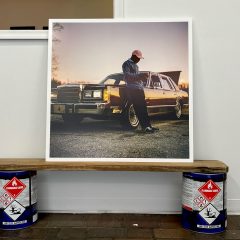[Elizabeth tours an upbeat, five-artist show that tests conceptions of space and the picture plane — the Artblog editors]
Like a mullet haircut–“business up front and party in the back”–Rob de Oude and Enrico Gomez maintain Parallel Art Space in the Ridgewood neighborhood of Queens, New York and their respective studios as a single unit. Parallel’s current show, Off the Wall, pushes boundaries by challenging the traditional wall format, and includes work by Gilbert Hsiao, Stacie Johnson, Kim Tran, Ken Weathersby, and (former Philadelphian) Alex Paik, who opened a sequel to Tiger Strikes Asteroid in New York in 2012.
Capitalizing on the gallery’s high ceilings, and curated to “respond to patterns of painterly innovation” and “pull context into co-operation,” the formal sculptures/paintings weave, spin, fold, shimmy, and shake–plane, color, shape and form–into balanced abstract compositions with energized voids.
Positively cheerful negative space
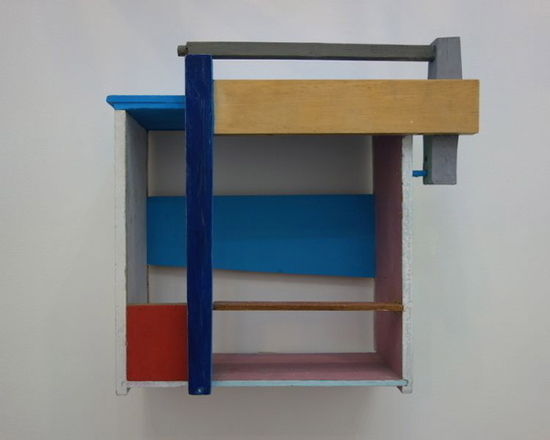
Kim Tran recycles furniture parts and bits of scrap wood into airy, polychrome, 3-D compositions. His designs seem to leap straight from a Modernist playbook, except that the pieces’ casual, rough finish declares that they are provisional. Sensuous, bentwood furniture-like curves activate pine-box slats and vivid color, and the resulting package carves and frames emptiness in a devil-may-care and cheerful way.
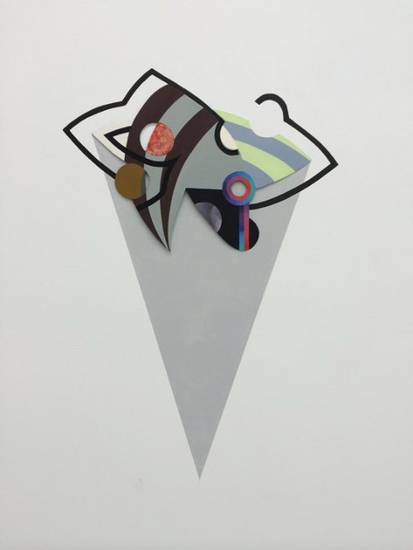
Stacie Johnson matches Tran’s visual rhythm and energy by maintaining perimeters and echoing retro design, but she cuts peephole patterns out of planes–letting the air in–or mimicks shadows with shaped voids. Her competing layers encourage viewers to try harder and imagine what lies behind and under surfaces. Complex, sandwich-like, sculptural puzzles contrast front against back, and 3-D space doesn’t always agree with 2-D illusion; consequently, I’m eager to wrestle with Johnson’s incongruities.
In plane view
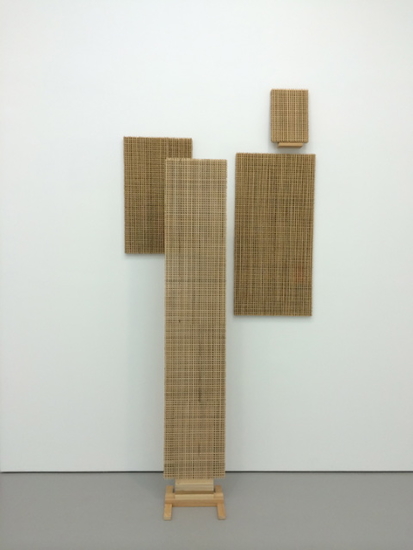
Working more flatly than Johnson and Tran, Ken Weathersby half-builds and half-infers where a picture plane might be, interrupting our view of a particular image or perspective. He builds grids that hover over an image or surface, resurrecting Clement Greenberg’s discussion from Modernist Painting on the “integrity of the picture plane”. In Ken’s work, the idea of integrity is as important as immateriality, since the ratio of gridded, thin wooden slats in proportion to divided gaps is balanced and equal. The mesh of warm wood hides, reveals, and stimulates the eye like an Arabic lattice pattern.
Weathersby’s “203 (museum bulletin 1982)” fuses a Triscuit-like grid with a Metropolitan Museum of Art bulletin image, recalling Jan van Eyck’s “Madonna of Chancellor Rolin” and other Renaissance depictions of the Madonna and Child on a diminishing parquet floor.I imagine tilting one of these Renaissance floors perpendicular to the viewer in the manner of Leo Steinberg’s “flat-bed picture plane,” and matching the decorated tiles to the voids in Weathersby’s wooden grid: I’m in conceptual limbo, in the “no-space space” that the artist is aiming for. Having his cake and eating it too, Weathersby effectively marries unrelated art historical concepts through a mashup of sculptural form and image.
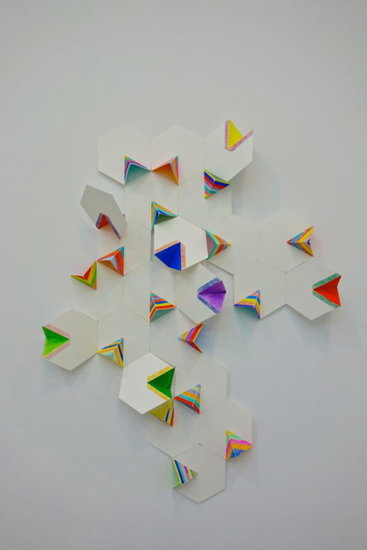
Echoing the strategies and rhythm of other work in Off the Wall, Alex Paik’s raucous, kite- or pinwheel-like abstractions seem to have just flown off the handle or broken a connecting string with convention. Modest-sized, origami-like folded paper cells and triangular sections are bound together into asymmetrical clusters. His “Right Triangle 1” and “Right Triangle 2” conspire with Weathersby’s grids, yet here, concept is less important; instead of associating ideas, I’m swept up into Carnival music and color. I’m especially impressed by the shadows cast on the gouache, colored pencil, and marker in Paik’s work, as they feel tepid lying on inexpensive, commercial color, yet they potently suggest depth. Compared to the first three artists, Paik’s work seems more shy or retreating, more part of the wall; because it flies in a different airspace from the others, the scope of the whole exhibit broadens.
A colorful marriage of art and participation
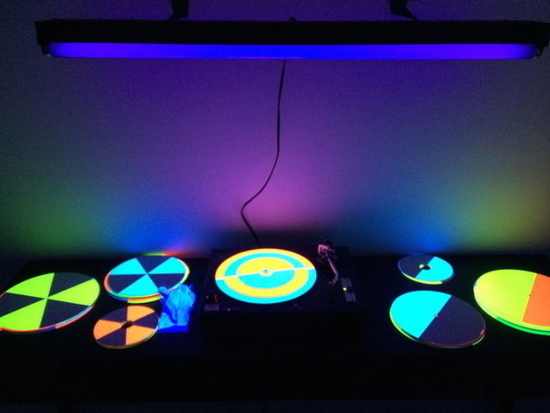
I step into an adjoining room…and into “Hit Parade,” and club-like darkness, and a brand new mood. Gilbert Hsiao has gathered and painted vinyl records–45s, 78s, and 33s–for visitors to stack and spin on various turntables, and the spaciousness and relative ease of the piece invites participation. The disks are divided into sections of bright fluorescent color, and glow in the ambient ultraviolet light. Because they are painted, these records can’t play; music by composer/artist Leif Inge, who takes Beethoven’s ninth symphony and stretches it out to 24 hours as “9 Beet Stretch,” fills the bill. Folks enjoy spinning the hypnotizing, colored disks, and Hsiao simply and efficiently connects color, shape, and sound as painting, sculpture, music and performance. Reminiscing about record labels while listening to minimalist music is a great way to wind up Off the Wall.
Off the Wall challenges the traditional wall format with aggressive, proactive sculptures, riffing on the Modernist and Renaissance canons, and stirring up nostalgia for vinyl, lattice screens, bentwood, and mid-century design. As generous to viewers as it is self-serving, the gallery/studio blend seems to be suitable for many artist-curators in Bushwick today.
Off the Wall is up at Parallel Space at 1717 Troutman Street, #220, Ridgewood (Queens), NY 11385, through March 23, 2014.


